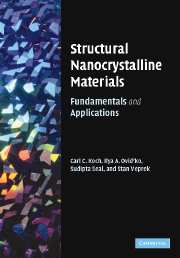Book contents
- Frontmatter
- Contents
- Preface
- Acknowledgments
- 1 Introduction
- 2 Processing of structural nanocrystalline materials
- 3 Stability of structural nanocrystalline materials – grain growth
- 4 Mechanical properties of structural nanocrystalline materials – experimental observations
- 5 Mechanical properties of structural nanocrystalline materials – theory and simulations
- 6 Corrosion of structural nanomaterials
- 7 Applications of structural nanomaterials
- Index
- References
7 - Applications of structural nanomaterials
Published online by Cambridge University Press: 04 December 2009
- Frontmatter
- Contents
- Preface
- Acknowledgments
- 1 Introduction
- 2 Processing of structural nanocrystalline materials
- 3 Stability of structural nanocrystalline materials – grain growth
- 4 Mechanical properties of structural nanocrystalline materials – experimental observations
- 5 Mechanical properties of structural nanocrystalline materials – theory and simulations
- 6 Corrosion of structural nanomaterials
- 7 Applications of structural nanomaterials
- Index
- References
Summary
Introduction
The very early application of nanomaterials is utilized in systems where nanopowders are used in their free form, without consolidation or blending. For a simple example, nanoscale titanium dioxide and zinc oxide powders are now commonly used by cosmetics manufacturers for facial base creams and sunscreen lotions for UV protection. Nanoscale iron oxide powder is now being used as a base material for rouge and lipstick. Paints with reflective properties are also being manufactured using nanoscale titanium dioxide particles. Figure 7.1 lists some of the common current and future applications of nanomaterials. The list is not complete, however; it is a current summary and the view of the present authors.
Nanostructured wear-resistant coatings for cutting tools and engineering components have been in use for several years. Nanostructured cemented carbide coatings are used on some Navy ships for their increased durability. Recently, more sophisticated uses of nanoscale materials have been realized. Nanostructured materials are in wide use in the area of information technology, integrated into complex products such as the hard disk drives that provide faster communication in today's world.
Many uses of nanoscale particles have already appeared in specialty markets, such as defense applications, and in markets for scientific and technical equipment. Producers of optical materials and electronics substrates such as silicon and gallium arsenide have embraced the use of nanosize particles for chemomechanical polishing of these substrates for chip manufacturing.
- Type
- Chapter
- Information
- Structural Nanocrystalline MaterialsFundamentals and Applications, pp. 341 - 361Publisher: Cambridge University PressPrint publication year: 2007
References
- 1
- Cited by



